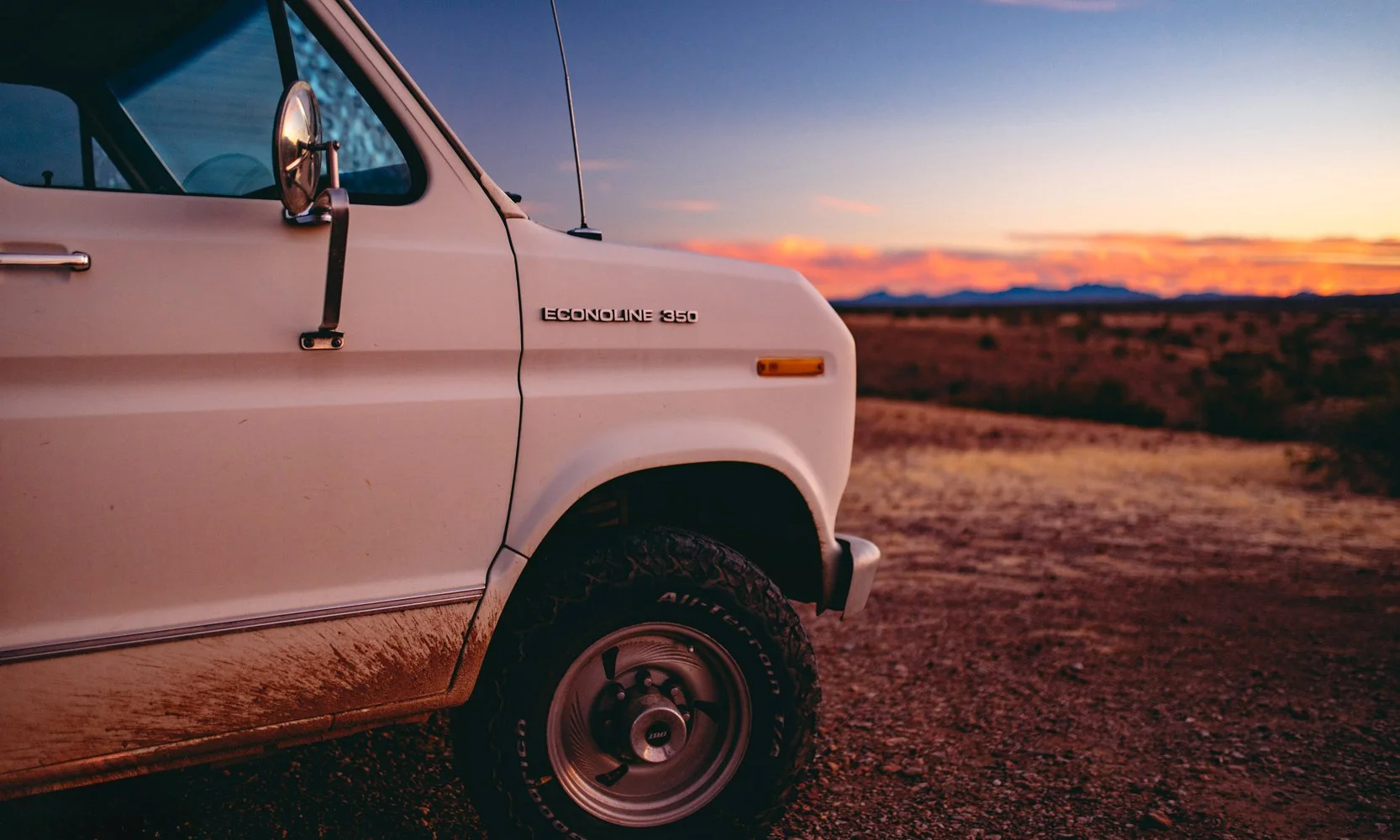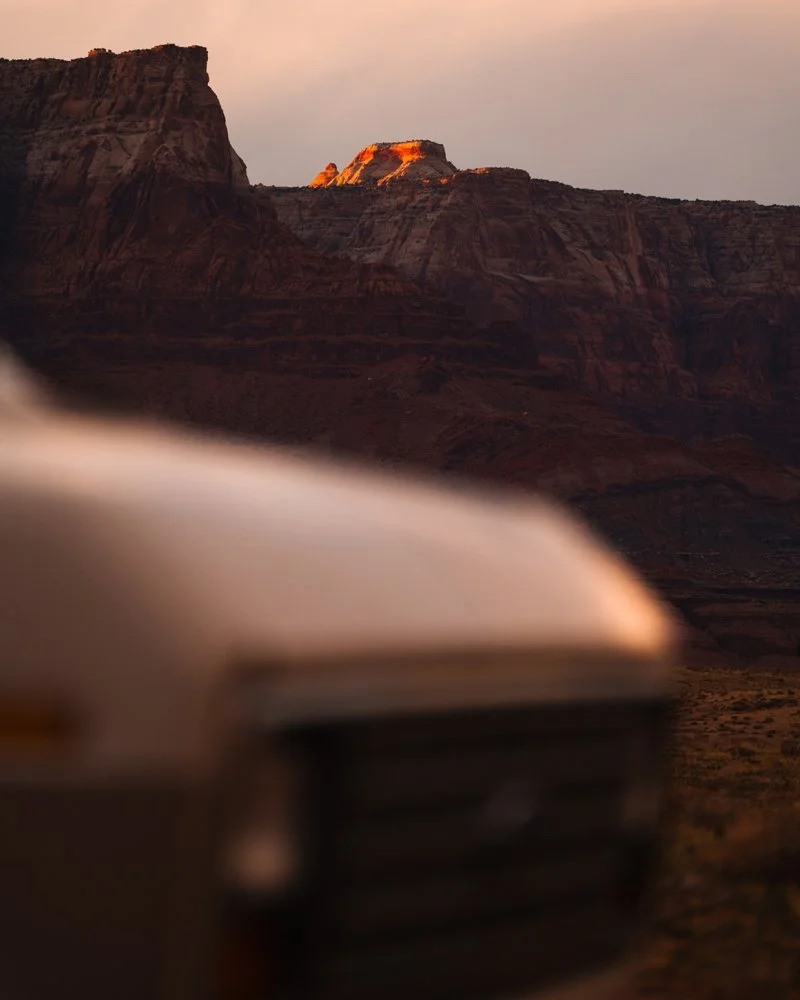Dispersed Camping Etiquette & Fostering Respect with Locals
Logan’s van soaking in the sunset views at a dispersed campsite in the desert near Safford, AZ. Land ownership: Bureau of Land Management
When recreating on public lands, I’ve run across a few folks protective of their corner of the woods. Ranchers and people who live nearby are often the frequent offenders.
“You can’t be here,” they exclaim.
And it’s a sentence that makes my blood boil but then, I force myself to calm down and address the root of the problem.
Because people don’t want to see their public lands get ruined, or over-Instagrammed to death, or god forbid, let those barefoot hippies near them. And that’s somewhat understandable. Having lived in a van for the past 8 years, I’ve had my share of run-ins with people who’d rather I not stick around.
We can’t work with what we don’t know. Half the time, the locals just want to be heard, respected and know we won’t trash the place. Positive encounters go a long way to making them more comfortable with our type.
So the goal of this blog is to provide context and techniques to relate to those who don’t want you there.
(DISCLAIMER: This is not advice you should apply to every interaction. If you feel unsafe, leave. You know the difference between when someone is being unreasonable or outright dangerous.)
A little more about me: I started working as a ranger for the Forest Service in Sedona back in 2018 and spent the next 6 years working for federal agencies on public lands. And I learned a lot about how land management agencies enforce dispersed camping rules.
The biggest piece of advice I can give you is that almost every parcel of public land is different. You must look up the local restrictions from place to place, particularly fire restrictions. (You will get kicked out or fined so fast if you’re having an illegal campfire. People will report you so fast. Be smart)
Logan & Chasing Candice’s vans perched at a remote dispersed site in the Arizona desert near Lee’s Ferry.
Let’s break it down into three categories:
Land ownership and knowing where you’re recreating
How to converse with upset individuals who feel you’re breaking rules
How to leave the conversation ensuring everyone feels better
Land ownership and knowing where you stand
The big three agencies in the public lands space are the Bureau of Land Management, the Forest Service and individual state lands/forests. There’s PLENTY of spaces like this in the Western United States, and much less as you move eastward. (See my additional resources below for an East Coast dispersed camping guide.)
It is up to you to know the local rules and regulations and do your best to seek them out. If the rules state you can only camp 50 feet off the main road without negatively impacting the local flora in the National Forest and you’re 200 feet away and drove through a flower patch, that’s illegal. And you need to do better. For yourself, for all of us, and for our wonderful planet.
The best thing you can do when it comes to land ownership is to know who manages the ground you’re standing on. There are a multitude of apps/websites that give you access to such data.
Nothing more special than a desert sunset from your own personal campsite.
Some of my favorites:
Gaia GPS: map in the free version is pretty good, paid version is insanely awesome.
CalTopo: free version has public land layers along with plenty of other cool features. It’s the best free mapping application around in my opinion.
Boondocker’s Bible: contains basic public land layer features and shows campsites vetted by other travelers.
Motor Vehicle Use Maps: For national forest land specifically, type in the forest you wish to visit in your search engine and add “MVUM.” The Motor Vehicle Use Map contains all the information needed to see which roads you can drive on, what times of the year, what dispersed camping is available and rules that apply. Powerful tool!
Knowing your rights intimately is essential. It’s hard for someone to argue when you know exactly what parcel of land you’re standing on and how all the rules apply. And you can point it out on an official map with property boundaries.
Conversating with people who feel you’re breaking the rules
People that react negatively to your presence often feel like the government applies their laws unfairly. Especially ranchers and folks who live in the northern Rockies. And that’s a complicated history that deserves its own deep dive. But the key takeaway is that those folks have probably had run-ins with land management agencies that felt unfair, or they misinterpreted local rules and were penalized for it.
They either think you’re breaking a rule they’ve been caught for in the past or in their mind, “just know” what you’re doing is illegal. Either way, you’ve got to tread lightly and calm them down a little. Emotional intelligence is a vital asset when navigating upset individuals who are willing to confront you.
In this moment, it’s in your best interest to determine why the said party is upset with you. Is it something they think you’ve done? Or are they projecting their past negative experiences? Do they wish to save you time and frustration or are they trying to get into your head? Do your best to understand what’s happened to them and diffuse the encounter calmly.
How to leave the conversation ensuring everyone feels better
When people come your way with the “you’re not allowed to be here” or “I got a fine once” approach, they just want to be heard. And if you’re not combative, they will be more at ease. Next, my typical response is to ask them if they’re personally upset if I’m there. They will usually say, “well no…”
If that’s their response, I recommend telling them that if they’re cool, we’re cool. And that you’re perfectly willing to speak with a ranger if they put them on the phone or called them out. And tell them about how you’re going to treat the space well and leave it better than you found it. (And are aware of any fire restrictions.)
If they are upset that you’re there, ask them what makes them uncomfortable and do your best to explain you’re leaving no trace, you’re not inviting 12 more people to the area, that you’re only there for the night, that kind of thing. Feel it out whether they like that response. Again, if it feels unsafe, leave. No campsite is ever worth putting yourself in a threatened position.
This whole process gives them the ability to graciously exit the conversation and save face in the process. They’re wrong, but you were nice about it. It leaves a better taste in their mouth for everyone that comes behind you.
Have any more tips and tricks you’ve personally used in the past or that we should know about?
Let me know in the comment section below!
Candice adjusts her hair in the window of the van while dispersed camped on public lands.
Additional resources:
When writing this post, I asked myself…what do I have to say that’s not been said all over the internet already. I’ve seen lots of folks talk about how to disperse camp. But no one talks about when grumpy humans don’t think you’re doing the right or responsible thing. For all the nitty gritty details of how to disperse camp, please see this list of resources below. Tons of people have written wonderful things about the subject!
Bureau of Land Management camping guidelines:
https://www.blm.gov/programs/recreation/camping
US Forest Service camping guidelines vary by forest, find yours here:
https://www.fs.usda.gov/visit/forests-and-grasslands
Beginner’s guide to dispersed camping:
https://nationalparkssupplyco.com/blogs/resources/beginners-guide-to-dispersed-camping
Best beginner friendly ways to find easier camping:
https://ioverlander.com/explore
Notes on East coast dispersed camping:
https://escapecampervans.com/blog/tips-for-dispersed-camping-on-the-east-coast/
Sourcing camping spots via Google maps, Gaia GPS, CalTopo (pro mode):
https://www.overlandmama.com/dispersed-camping/how-to-find-dispersed-wilderness-camping-spots
Urban stealth camping tips & tricks:
Affiliate disclaimer: These are items that I personally recommend as being high-quality and user-friendly. If you make a purchase after clicking one of these affiliate links, I’ll earn a small commission at no cost to you. This supports me as a creator and you will not pay a higher price. Thanks for your help!



